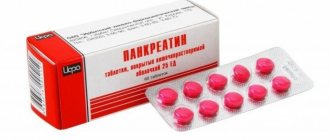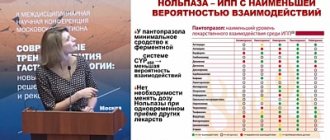Everyday life
When we eat more than we need or eat food that is unusual for our body, the body may not have enough of its own enzymes to fully digest it. Heaviness in the abdomen, discomfort after eating, bloating, belching, flatulence may occur2. These symptoms may appear in combination or separately, pass by morning or torment for several days.
This state of affairs cannot be called unexpected. As a rule, many people associate the upcoming feast with a large number of treats, which are almost impossible to resist. Therefore, the consequences in the form of heaviness after eating are often a predictable outcome.
In such a situation, many of us are at a crossroads: to help digestion with medication or to endure unpleasant symptoms (after all, frequent use can be harmful).
There is no point in waiting for the heaviness and discomfort after eating to go away on their own, and putting up with the thoughts of “where to lie down” and “why did I eat all this?” We reveal all the secrets below.
Pancreatin-LekT (tablet p/o No. 60 (sheet 15x4))
A country
Russia
The country of production may vary depending on the batch of goods. Please check with the operator for detailed information when confirming your order.
Active substance
Pancreatin
Compound
For 1 tab. pancreatin 90 mg, with enzymatic activity: - lipase not less than 3,500 units; — amylase not less than 3,500 units; — proteases 200 IU. Excipients: calcium stearate, lactose, low molecular weight povidone, microcrystalline cellulose. Composition of the enteric coating: macrogol 6000, copolymer of methacrylic acid and ethyl acrylate, polysorbate-80, talc, azorubine dye, titanium dioxide.
pharmachologic effect
Enzyme agent. Contains pancreatic enzymes - amylase, lipase and proteases, which facilitate the digestion of carbohydrates, fats and proteins, which facilitates their more complete absorption in the small intestine. In diseases of the pancreas, it compensates for the insufficiency of its exocrine function and helps improve the digestion process.
Indications for use
Insufficiency of the exocrine function of the pancreas (including in chronic pancreatitis, cystic fibrosis). Chronic inflammatory-dystrophic diseases of the stomach, intestines, liver, gall bladder; conditions after resection or irradiation of these organs, accompanied by disturbances in the digestion of food, flatulence, diarrhea (as part of combination therapy). To improve food digestion in patients with normal gastrointestinal function in case of errors in nutrition, as well as in cases of disorders of chewing function, forced long-term immobilization, sedentary lifestyle. Preparation for x-ray and ultrasound examination of the abdominal organs.
Mode of application
The dose (in terms of lipase) depends on age and the degree of pancreatic insufficiency. The average dose for adults is 150,000 units/day. In case of complete insufficiency of exocrine pancreatic function - 400,000 units/day, which corresponds to the daily requirement of an adult for lipase. The maximum daily dose is 15,000 units/kg. Children under 1.5 years of age - 50,000 units/day; over 1.5 years - 100,000 units/day. The duration of treatment can vary from several days (if the digestive process is disrupted due to errors in the diet) to several months and even years (if constant replacement therapy is necessary).
Interaction
When used simultaneously with antacids containing calcium carbonate and/or magnesium hydroxide, the effectiveness of pancreatin may be reduced. With simultaneous use, it is theoretically possible to reduce the clinical effectiveness of acarbose. With simultaneous use of iron preparations, a decrease in iron absorption is possible.
Side effect
When used in average therapeutic doses, side effects are observed in less than 1%. From the digestive system: in some cases - diarrhea, constipation, discomfort in the stomach, nausea. The cause-and-effect relationship between the development of these reactions and the action of pancreatin has not been established, because these phenomena refer to symptoms of exocrine pancreatic insufficiency. Allergic reactions: in some cases - skin manifestations. Metabolism: with prolonged use in high doses, the development of hyperuricosuria is possible; in excessively high doses - an increase in the level of uric acid in the blood plasma. Other: When using pancreatin in high doses in children, perianal irritation may occur.
Contraindications
Acute pancreatitis. Hypersensitivity to pancreatin.
special instructions
Use in the acute phase of chronic pancreatitis is not recommended. For cystic fibrosis, the dose should be adequate to the amount of enzymes that is necessary for the absorption of fats, taking into account the quality and quantity of food consumed. For cystic fibrosis, the use of pancreatin in doses of more than 10,000 units/kg/day (in terms of on lipase) due to an increased risk of developing strictures (fibrous colonopathy) in the ileocecal region and in the ascending colon. With high activity of lipase contained in pancreatin, the likelihood of developing constipation in children increases. Increasing the dose of pancreatin in this category of patients should be carried out gradually. Disturbances from the digestive system may occur in patients with hypersensitivity to pancreatin, or in patients with meconium ileus or a history of intestinal resection.
How can you help yourself?
As we found out, the cause of heaviness after eating may be a lack of digestive enzymes. To eliminate this deficiency, there are special drugs. Most of them contain pancreatin. We dealt with this concept above. But, if the active ingredient is the same, does this mean that there is no difference between the drugs?
Secret No. 1
The effectiveness of the drug against heaviness after eating directly depends on the size of its particles, and not just on the composition! Science has proven that small particles are important for better digestion3.
Scientists came to this conclusion after many years of studying the digestive process and the effect of various forms of enzyme preparations (tablets, larger particles, etc.). A drug that has gone through all the stages of evolution of drugs to aid digestion is Creon®. The history of its appearance and development goes back more than 100 years.
At one time, starting in the 1960s, Creon® was available in the form of a large solid tablet4. The undying desire to increase its effectiveness led to the fact that the drug was transformed from a tablet into a capsule with granules. However, these granules were still too large to integrate into the human digestive process as naturally as possible. And then the large particles became even smaller and were called “minimicrospheres”. Today, there are more than 500 minimicrospheres measuring 0.7-1.6 mm5,7 inside the Creon® capsule. Creon® contains such particles that are produced using patented technology4.
Secret No. 2
The enzymes that make up pancreatin are identical to those produced by the body. In this regard, when taking Creon®, the body does not stop digesting food itself8. Creon® only complements its independent work, so you can take the drug every time you feel heavy after eating9.
What else is important to know about enzyme preparations?
PANCREATIN-LEKT (tablets)
reparative, but its name is not commercial, but based on its active substance.
And his price is not commercial, but “for people.” Whether LekT is pancreatin or not LekT is not important to me. And the important thing is that when I am full, so that I can then, firstly, get up from the table, and secondly, live my day without being tormented by heaviness, rumbling and grumbling.
This very substance helps to avoid this - pancreatin, which consists of digestive enzymes - protease, lipase, amylase. For those ignorant of medicine and pharmacology in particular, I will explain that they are the ones who uncouple proteins, fats and carbohydrates in the stomach (I roughly explained, very roughly. But I still conveyed the main meaning).
The cardboard box contains a bottle in which the tablets themselves rattle.
The tablets are pink, biconvex disks without a longitudinal stripe in the middle. Do you know why there is such a strip on the tablets? It’s just that when the patient does not want to swallow the tablet through the mouth, it can be screwed in with a screwdriver in the opposite direction. Joke.
The kit also includes fleece. Do you know about cotton wool? Why is it needed? No, no joke here - just like a desiccant. But it always bothers me a lot, I throw it away.
At the beginning of this review you will notice in red letters: Attention! Before using medications, consult a specialist!
And although pancreatin from all pharmaceutical companies is dispensed from pharmacies without a doctor’s prescription, you should keep in mind that its absorption after each meal can lead to the fact that your stomach simply forgets how to produce digestive enzymes on its own and you can become a pancreatin addict.
I will show you the indications, contraindications and method of use in the instructions.
The fact that a medicine is inexpensive and does not require a prescription does not mean that it ceases to be a medicine. And the task of any medicine is to help the body cope with the difficulties that have arisen, and not solve them without its participation.
Therefore: eat in moderation, do not overeat, remember the advice: you need to get up from the table with the feeling that you would have eaten the same amount.
But if there is a banquet, corporate party, restaurant, birthday, meeting of classmates, graduates, friends, drinking buddies, Maslenitsa, Easter, New Year and other joys of the belly - then pancreatin will help you.
Take care of yourself! After all, you are your own dearest person.
Your Beauty Eleonora.
How does Creon® work?
Once in the stomach, the Creon® capsule quickly dissolves9, and hundreds of small particles are evenly distributed in the food eaten. Uniform mixing is one of the key properties required for an enzyme preparation. Only in this way will it be able to “cover” the maximum volume of food and help in its complete digestion7.
Since the key stage of digestion occurs in the intestines, and not in the stomach, as is commonly thought, it is important for the drug to get there simultaneously with food. And here Creon® also copes with the task: thanks to uniform mixing, the particles of the drug “accompany” food into the intestines to help it be fully digested7.
Thus, the Creon® capsule with mini-microspheres helps the active substance get to where it needs to work and fully support digestion.
To learn more
To eliminate heaviness after meals, as a rule, take 1 capsule of Creon® 10000 during or immediately after meals9. If the capsule is difficult to swallow, you can open it and add minimicrospheres to liquid or mix with food9. More detailed information about the rules of administration can be found in the instructions for medical use.
Creon® 10000 can be useful if you are planning a feast, a trip, and especially a vacation, when it is even more difficult to give up gastronomic excesses. Wherever heaviness may lurk after eating, caring mini-microspheres can support your digestion.
Pancreatin
Pancreatin is a digestive enzyme used for insufficient secretory activity of the pancreas, as well as for various types of dyspeptic disorders. Pancreatin is much better known to a wide range of average visitors to clinics under the Mezim brand of the German pharmaceutical giant Berlin Chemie, but there are prophets in their native land (under the trade name “Pancreatin” the drug is produced exclusively in Russia). So, the pharmacological effect of this drug is associated with the replacement of enzymes secreted under normal conditions by the pancreas, which, as is known, is one of the most important participants in the digestive process. Pancreatin compensates for the lack of exocrine activity of this enzyme “generator” and has a proteolytic (protein breakdown), amylolytic (starch breakdown) and lipolytic (fat breakdown) effect. Pancreatin contains four digestive enzymes (trypsin, chymotrypsin, amylase, lipase), thanks to which protein is broken down into amino acids, fats into fatty acids and glycerol, starch into monosaccharides and dextrin. In addition to its destructive functions in the good sense of the word, pancreatin normalizes the functional state of the digestive tract and optimizes the digestive process.
The enzyme trypsin suppresses stimulated pancreatic secretion and has an analgesic effect.
Pancreatin is available in the form of enteric-coated tablets. At the same time, the manufacturer provides that the dosage form does not degrade in the aggressive acidic environment of the stomach, but begins to release the active substance when it enters a “friendly” alkaline environment. It is best to take Pancreatin during or immediately after a meal, washing down the tablet with some non-alkaline drink (fruit juice or plain water). The dose is determined by the doctor in each specific case. According to general recommendations for adults, it is 2-4 tablets 3-6 times a day with a maximum dose of 16 tablets. For children over 6 years of age, pancreatin is indicated only in consultation with a doctor. As a rule, in standard situations he prescribes 1 tablet 3 times a day. The duration of the course of treatment can vary within a fairly wide range: from 2-3 days (with correction of the digestive process due to dietary disorders) to several months or even years (with replacement therapy on an ongoing basis).
Pancreatin-lect 90 pcs. enteric-coated tablets
pharmachologic effect
Enzyme agent. Contains pancreatic enzymes - amylase, lipase and proteases, which facilitate the digestion of carbohydrates, fats and proteins, which facilitates their more complete absorption in the small intestine. In diseases of the pancreas, it compensates for the insufficiency of its exocrine function and helps improve the digestion process.
Composition and release form Pancreatin-lect 90 pcs. enteric-coated tablets
Tablets - 1 tablet:
- Active substance: pancreatin 90 mg, with enzymatic activity: lipase not less than 3,500 IU, amylase not less than 3,500 IU, protease 200 IU.
- Excipients: calcium stearate, lactose, low molecular weight povidone, microcrystalline cellulose.
- Composition of the enteric coating: macrogol 6000, copolymer of methacrylic acid and ethyl acrylate, polysorbate-80, talc, azorubine dye, titanium dioxide.
10 pieces. — contour cell packaging (9) — cardboard packs.
Description of the dosage form
Enteric-coated tablets.
Directions for use and doses
The dose (in terms of lipase) depends on age and the degree of pancreatic insufficiency. The average dose for adults is 150,000 units/day. In case of complete insufficiency of exocrine pancreatic function - 400,000 units/day, which corresponds to the daily requirement of an adult for lipase.
The maximum daily dose is 15,000 units/kg.
Children under 1.5 years old - 50,000 units/day; over 1.5 years - 100,000 units/day.
The duration of treatment can vary from several days (if the digestive process is disrupted due to errors in the diet) to several months and even years (if constant replacement therapy is necessary).
Pharmacokinetics
The pharmacokinetics of pancreatin have not been studied.
Indications for use Pancreatin-lect 90 pcs. enteric-coated tablets
Insufficiency of exocrine pancreatic function (including in chronic pancreatitis, cystic fibrosis).
Chronic inflammatory-dystrophic diseases of the stomach, intestines, liver, gall bladder; conditions after resection or irradiation of these organs, accompanied by impaired digestion of food, flatulence, diarrhea (as part of combination therapy).
To improve the digestion of food in patients with normal gastrointestinal function in case of errors in nutrition, as well as in cases of impaired chewing function, forced long-term immobilization, and a sedentary lifestyle.
Preparation for x-ray and ultrasound examination of the abdominal organs.
Contraindications
Acute pancreatitis. Hypersensitivity to pancreatin.
Application of Pancreatin-lect 90 pcs. Enteric-coated tablets during pregnancy and breastfeeding
The safety of using pancreatin during pregnancy has not been sufficiently studied. Use is possible in cases where the expected benefit to the mother outweighs the potential risk to the fetus.
In experimental studies, it was established that pancreatin does not have a teratogenic effect.
Use in children
Application is possible according to the dosage regimen. With high lipase activity contained in pancreatin, the likelihood of developing constipation in children increases.
special instructions
Use in the acute phase of chronic pancreatitis is not recommended.
For cystic fibrosis, the dose should be adequate to the amount of enzymes that is necessary for the absorption of fats, taking into account the quality and quantity of food consumed.
For cystic fibrosis, the use of pancreatin in doses of more than 10,000 units/kg/day (in terms of lipase) is not recommended due to the increased risk of developing strictures (fibrous colonopathy) in the ileocecal region and in the ascending colon.
With high lipase activity contained in pancreatin, the likelihood of developing constipation in children increases. Increasing the dose of pancreatin in this category of patients should be carried out gradually.
Digestive system disorders may occur in patients with hypersensitivity to pancreatin, or in patients with meconium ileus or a history of intestinal resection.
Side effects Pancreatin-lect 90 pcs. enteric-coated tablets
When used in average therapeutic doses, side effects are observed in less than 1%.
From the digestive system: in some cases - diarrhea, constipation, discomfort in the stomach, nausea. The cause-and-effect relationship between the development of these reactions and the action of pancreatin has not been established, because These phenomena refer to symptoms of exocrine pancreatic insufficiency.
Allergic reactions: in some cases - skin manifestations.
On the metabolic side: with long-term use in high doses, the development of hyperuricosuria is possible; in excessively high doses, an increase in the level of uric acid in the blood plasma.
Other: when using pancreatin in high doses in children, perianal irritation may occur.
Drug interactions
When used simultaneously with antacids containing calcium carbonate and/or magnesium hydroxide, the effectiveness of pancreatin may be reduced.
With simultaneous use, it is theoretically possible to reduce the clinical effectiveness of acarbose.
With simultaneous use of iron supplements, a decrease in iron absorption is possible.


